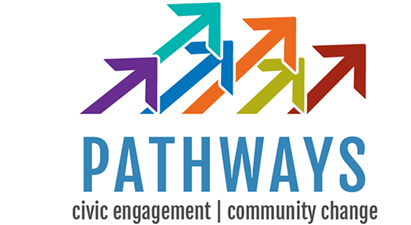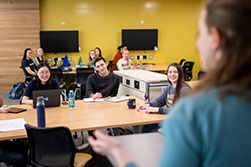This is the third of a three-part series by CRLT and the Ginsberg Center outlining strategies and resources that instructors can use to plan, frame, and facilitate conversations about the 2020 Election.  In Part 1 of this CRLT/Ginsberg Election Resource series, we suggest that instructors from every discipline can address the 2020 Election in their courses in order to help students build and practice fundamental skills required for democracy. In Part 2, we outline a step-by-step process for making decisions about how to structure and facilitate an actual classroom conversation about the election.
In Part 1 of this CRLT/Ginsberg Election Resource series, we suggest that instructors from every discipline can address the 2020 Election in their courses in order to help students build and practice fundamental skills required for democracy. In Part 2, we outline a step-by-step process for making decisions about how to structure and facilitate an actual classroom conversation about the election.
After the election, students may experience a range of reactions that may impact their ‘bandwidth’ for learning and participation in your course. Regardless of political affiliation, students may be focused on managing the impacts of the election on their own lives and thinking about ‘what happens next.’ One way that you can support students in this moment is to highlight civic engagement as an ongoing, active practice that includes, but is not limited to, voting in an election.
This guide focuses on how you can help students channel their responses to the 2020 Election into action by 1) acknowledging their feelings, 2) connecting with your disciplines, and 3) recommitting to the many ways that they can continue to contribute to their communities through civic engagement.
1. WHAT MIGHT STUDENTS NEED BEFORE THEY CAN CHANNEL THEIR REACTIONS TO THE ELECTION INTO ACTION?
Before students can move to action, they may need space to process their reactions to the election. Acknowledging students’ feelings of frustration, anger, helplessness, or even joy & excitement after this national election season may be a necessary step before being able to discuss how they can shift to thinking or strategizing about actions. Some students, particularly those who have been disproportionately targeted or affected by negative political rhetoric, might need more time to process while others may be ready to shift to action sooner. If you have not already offered space during class for your students to process, our previous post offers ways to structure these discussions. To be mindful of the range of stakes involved, instructors can give students choices for how they debrief their reactions, from free-writing or individual reflections that are not shared with the class to carefully planned discussion activities organized around specific learning goals. You might also consider being flexible with assignments and deadlines as students process the election results in different ways and on different timelines. Make sure to check in with students about their readiness to talk about moving toward action.
2. HOW CAN DISCIPLINARY APPROACHES HELP STUDENTS RESPOND TO THE IMPACTS OF THE ELECTION?
Whether your course content is directly related to civic engagement or not, sharing how your discipline affects, interacts with, and shapes broader social systems significantly impacts students’ ability to understand and participate in civic life. Politics is about how we make collective agreements about allocating resources, therefore politics is inherent in all disciplines and fields. We offer the following questions to help your students better understand and make sense of this connection.
- How is academic knowledge produced in your field or discipline? Who is included in this knowledge production and who is left out?
- What examples can you share of how broader economic, political, health, educational and social systems impact your discipline or field?
- What forms of data and analysis are considered legitimate in your field and why?
- How has your field changed over time? What examples can you offer of current debates or competing schools of thought?
- How is your discipline or field affected by local, state or federal legislative policies or judicial decisions?
- How has your discipline or field informed local, state or federal legislative policies or judicial decisions?
- How can you help students identify ways to contribute to these processes?
These questions offer a starting point to make visible the decision-making mechanisms of your field. Perhaps more importantly, they allow students to consider ways they can contribute to or influence these mechanisms.
Resources:
- Civic Learning Activities (section on ‘Activities to Move Towards Action’)
- AACU’s Issue on Civic Learning in the Major by Design
- CEEP’s Coronavirus as a Teachable Moment
3. HOW CAN YOU HELP STUDENTS RECOMMIT TO CIVIC ENGAGEMENT?
While voting has been a key focus this election year, there are many other ways we and our students have agency in contributing to civic life. Civic engagement is not a single action, but a set of lifelong habits we can cultivate and practice to support and create thriving communities. This Ginsberg Center resource on Pathways to Civic Engagement and Community Change offers six, intersecting paths for you and your students to explore. Below we describe each pathway and offer a few examples of strategies instructors can use to support students exploring each pathway.
Questions to consider:
- Which of the pathways do you already support?
- Which might you need to learn more about to share with your students?
- How can you embed these pathways as avenues for action as part of your course?
Policy & Governance
Participating in democratic political and deliberative processes, policymaking, and public governance:
- Share the schedule of local public meetings and encourage students to attend, view online, or read minutes.
- Encourage students to contact local and national elected officials in writing or in person around issues they care about related to your discipline, field, or course content.
- Click here for additional strategies to support this pathway.
Direct Service
Working to address the immediate needs of individuals or a community, often through direct interaction with the people or place being served:
- Offer a curated list of engagement opportunities pulled from one of the databases below:
- Connect2Community (for opportunities in Southeast Michigan),
- Volunteer Portal (for the state of Michigan) or
- VolunteerMatch (for opportunities across the US).
- Ask students to reflect on how they are making connections between their experiences in a community-engaged student organization, co-curricular program, or service-year program and their classroom learning.
- Click here for additional strategies to support this pathway.
Community-Engaged Learning and Research
Connecting coursework, academic research, and outside of the classroom experiences to community-identified concerns to enrich knowledge and inform action on social issues:
- Assist students in using research to support local community efforts related to your field or discipline.
- Prepare your students to thoughtfully enter, engage, and exit communities.
- Click here for additional strategies to support this pathway.
Community Organizing & Activism
Involving, educating, and mobilizing individuals or groups to influence or persuade others toward attitude, policy, or culture change:
- Have students study a current or past social movement or community-led campaign related to your field and/or an issue they care about.
- Invite representatives from an action-oriented coalition on campus or in your community to speak with your class, department, or program.
- Click here for additional strategies to support this pathway.
Philanthropy
Donating or raising funds and resources for nonprofits and other non-governmental organizations that engage in work that contributes to the public good:
- Have students research local organizations that are related to course content and personal interests to support existing fundraising efforts or support new ones, such as donation drives for non-monetary items (clothes, materials, food, etc.).
- Encourage students to research different philanthropic efforts through sites such as GreatNonprofits, CharityNavigator, or the Philanthropic Initiative on Racial Equity.
- Click here for additional strategies to support this pathway.
Social Entrepreneurship
Using ethical business approaches to create or expand market-oriented responses to social or environmental problems and address the needs of underserved groups:
- Have students research existing efforts prior to proposing or creating new initiatives and identify the ways they can complement, enhance, or partner with these efforts.
- Share examples and research on how to maximize ethical practices (worker conditions, profit-sharing) as they explore social entrepreneurship.
- Click here for additional strategies to support this pathway.
As you support your students to make sense of their reactions to the election, consultants at CRLT and Ginsberg Center are available to talk with you about planning courses or class sessions. You can make an appointment through CRLT’s website or use Ginsberg Center’s Support Request Form.
- Log in to post comments
- 1538 views






